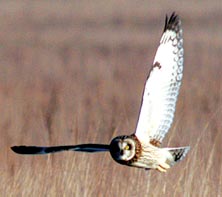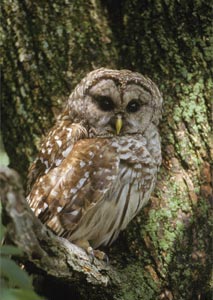Main Content
Article
Owls
 Watch barn owls on our Barn Owl Nest Cam
Watch barn owls on our Barn Owl Nest Cam
Have you ever spent the night around a campfire at one of the state parks, reservoirs or forests, heard a noise and wondered what it was? Did your breath stop and your ears perk up in hopes of hearing the sound again? During the nighttime hours the woods come alive, sometimes with the calls of owls.
All owls have different voices, or calls. Some owl calls are soothing like the great horned owl’s soft, low and steady hoot. Other calls can be somewhat scary like the scream of the eastern screech owl. And then there are the owl calls that are simply entertaining.
One of my favorites, the most common of entertainers, is the barred owl. It’s the owl that seems to converse with you and ask, “Who cooks for you? Who cooks for you all?”
The round-headed, brown-eyed barred owl gets its name from the brown, streaked, bar-like markings on its upper chest and neck. The feather color, or plumage, allows it to blend, or camouflage, with the color of the bark on trees, making the owl difficult to find.
One surefire way of knowing an owl has been in an area is the presence of owl pellets. Owl pellets can be found beneath an owl’s favorite roosting tree. Owls are carnivorous, meaning they only eat meat. Barred owls love mice, but they’ll also eat reptiles, amphibians, spiders, songbirds, and they’ve even been known to eat smaller owls. But the owl’s system is unable to digest anything but the flesh and soft parts of the animal. So what happens to the other parts of the animal? The owl eats the entire animal, but only the soft tissue is allowed to continue to the digestive tract. The remainder of the meal, the pieces of fur and bone, is stored in the stomach until all the parts ar e rolled into a tight, compressed oval—kind of like what a trash compacter does to trash. Once the owl has finished processing the pellet, it is regurgitated, coughed up. Owl pellets are an important factor in learning about owls; scientists collect and dismantle the pellets to tell what kind of animals owls eat.
e rolled into a tight, compressed oval—kind of like what a trash compacter does to trash. Once the owl has finished processing the pellet, it is regurgitated, coughed up. Owl pellets are an important factor in learning about owls; scientists collect and dismantle the pellets to tell what kind of animals owls eat.
In order to locate a meal, owls use their superb hearing and eyesight. If you ever spot an owl and see him turning his head away from you, don’t think he’s ignoring you; he couldn’t be more aware of your presence. He will turn his head with his ear toward the sound so that he is able to determine the exact distance of you, the intruder. The sound he hears will establish whether or not a potential meal is walking his direction.
Owls have unique feathers. They are designed with frayed, feathery ends, allowing silent flight. With this type of feather, they are able to fly swiftly, and quietly, to capture their prey without alarming it.
While owls are fun to listen to and watch it is important to keep in mind owls are powerful birds of prey. Always watch owls from a distance and never approach a nesting owl. A safe way to get to know these birds is through their nighttime calls. Contact your nearest State Park Interpretive Center and see when the next Owl Prowl is scheduled.
